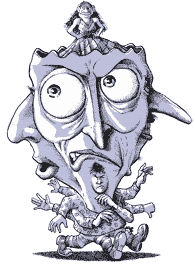[This is an email I received from Marc Angelucci. I’ll respond to it in my next post. – &]
Dear Ampersand,
Someone recently showed me your criticism of the comment I made while on the Phil Donohue Show that the government spends four times more on breast cancer research than prostate cancer research. I would like to briefly respond.
First, you cite data showing that the government spends two times more on breast cancer research than prostate cancer research, rather than four times more. However, you left out data from the past decade. The government spent four times more on breast cancer research than prostate cancer research at least from 1991 through 1999, and probably even beyond those years. The September 1997 issue of Men’s Health Magazine exposed this same 4X disparity and even looked at different government agencies. For example, the Department of Defense spent $20M on prostate cancer and $455M on breast cancer from 1993 to 1996. How do you justify that?
For the future I will say “multiple times” instead of “four times. But any recent increase in prostate cancer spending does not in my opinion change the huge, lengthy disparity that has taken place. And the myth women were excluded from medical testing has not only been repeatedly refuted – but it wouldn’t justify the disparity that took place even if it did happen, especially with current mortality rates being equal.
Second, you mention other factors to explain the disparity, such a higher diagnosis rate for women, a younger average age of the victims for breast cancer, and less activism on the part of men.
On the diagnosis rate, I’m not sure who is right. The figures I’m looking at published in Men’s Health from the American Cancer society show that in 1996, 317,000 men were diagnosed with prostate cancer and 184,000 women were diagnosed with breast cancer.
In any case, the mortality rates are indeed about equal. Even if the diagnosis rate were higher for women, that would arguably indicate that prostate cancer has been a lot more deadly for men. And the argument about younger victims can be seen as a form of “ageism” whereby older people are assigned less value. Regardless, differences in diagnosis rates and victim’s ages may justify *some* disparity, but in no way does it justify the enormous disparity that has occurred, especially with equal mortality rates. The fact is that no difference is more marked than the gender difference. Men make only 1% of breast cancer victims and 100% of prostate cancer victims. That is the main reason behind the disparity.
The difference in activism rates is a good point. Men and the women who love them have been less active on men’s issues than women and the men who love them have been for women’s issues. That can be attributed to a number of things, such as the male breadwinner role, men working 17 hours more per week than women outside the home, men being taught to not complain and to be silent suffering, and the overall societal inattention to male issues. I believe this too reflects the societal belief that male lives are less valuable than women’s and that men need to protect women, letting women into the lifeboats first and addressing their own needs only after women’s have been met. Our efforts to create even one office of men’s health compared to the seven federal offices of women’s health have met a great deal of opposition, both subtle and overt, and from both feminist groups and from chivalrous, “protect-women” folks who think men don’t need any help. This problem does not refute my point. It supports it, especially since judges and politicians listen to their constituency groups and to money more than anything else.
Third, you put words in my mouth by saying that I claim the breast cancer vs. prostate cancer disparity proves that politicians and judges are biased against men. I did not say it proves it. I cited it as one example of it.
The “proof,” to me, is when you look at all the other disparities combined.
One example is criminal sentencing disparities. Males get much higher sentences than women for the same crime even when you make all other factors the same, including age, race, family situation and number of priors. The disparity persists even when you look only at the gender of the victim instead of the accused. A drunk driver who kills a female gets a three year higher sentence than a drunk driver who kills a male, even when all factors are the same. How do you explain that one, Amp?
Another example can be see by looking at a sample of the laws in California that discriminate against males. This has gone on for years with nobody challenging it. (Link to PDF file.)
Another example is the way the Forced Labour Convention of 1930 forbade forced labor and then, created an exception for “adult able-bodied males” between 18 and 45 years old. (Link) I quote it here:
Convention concerning Forced or Compulsory Labour; 01:05:1932; Convention: C029 Geneva Session of the Conference:14 Date of adoption: 28:06:1930 # (Link)
“Article 11. 1. Only adult able-bodied males who are of an apparent age of not less than 18 and not more than 45 years may be called upon for forced or compulsory labour.”
When you look at draft registration laws, forced labor laws, child custody decisions, and other discriminatory policies and anti-male disparities, often created by males, then the historically huge disparity in spending on prostate cancer versus breast cancer research does demonstrate our government’s devaluation of the well-being of the human male. In my opinion, it is quite obvious.
Marc Angelucci



Although to my eyes panel 2 isn’t necessarily rich – he could easily be working class. For some reason, my…